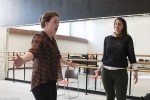Title
The following is excerpted from director Mary Birnbaum’s program note for Die Zauberflöte, which opens on April 19. The note can be read in its entirety— along with this year’s other Juilliard programs— at juilliard.edu/program-notes-archive.
Body
A marriage of opposites, Mozart’s Enlightenment masterpiece Die Zauberflöte touches our hearts by presenting the panoply of human possibility, and I have loved it since before I had the cognitive ability to know why I loved it. I knew I wanted Juilliard Opera’s production to be simple and elegant, in the same way as I hear the music. I also knew that I wanted the costumes to expose, rather than hide, the humanity of each character.
I wanted to see the Queen of the Night and Sarastro (Önay Köse) struggle with their problems, to divest them of golden robes and mountainous headdresses. The designers and I took inspiration from the bird and planetary imagery in Joseph Cornell’s boxes, Joseph Campbell’s work on the hero’s journey, and Karl Jung’s alchemical images as seen in Edward Edinger’s Mysteries of the Coniunctio. The space is loosely based on research about Masonic lodges in New England, and the natural elements we portray come from that region as well.
This particular Die Zauberflöte considers Pamina (Christine Taylor Price) and Tamino (Miles Mykkanen) to be two halves of a whole, enlightened person. At the beginning,
a system of discrete opposites is breaking down; the first words of the opera are “help me!” Through their journey, our heroes become whole by individuating from their pasts and integrating all the different lessons they learn along the way. At the end, they find a new wholeness: in a sophisticated other, as in the case of Pamina and Tamino, or, more naïvely, in the mirror, as Papageno (Theo Hoffman) and Papagena (Kara Sainz), who echo his every desire, changing only a vowel here and there.
Our idea of Enlightenment is very different from Mozart’s Enlightenment, when it was revolutionary just to posit that an (educated white) man could attain an equal rational footing with God and King. In 2016, there’s room for female and male, for light and dark—there’s room to unify and embrace the contradictions that shape human experience, and there’s room for the messiness and emotion that those contradictions give way to.
At polar opposites in the piece are the Queen of the Night and Sarastro, who serve as two examples of how to make your way in the world. Each has his/her virtues: Sarastro is hierarchical, rational, codified, and rigorous, the Queen of the Night is wild, passionate, and mysterious. For Pamina to truly grow, she has to borrow from both of her parents and integrate the type of female power that prizes intuition over rationality without dispensing with reason altogether. If she continued to color within the lines, she would never break into the final trial and lead the way through the elements.





